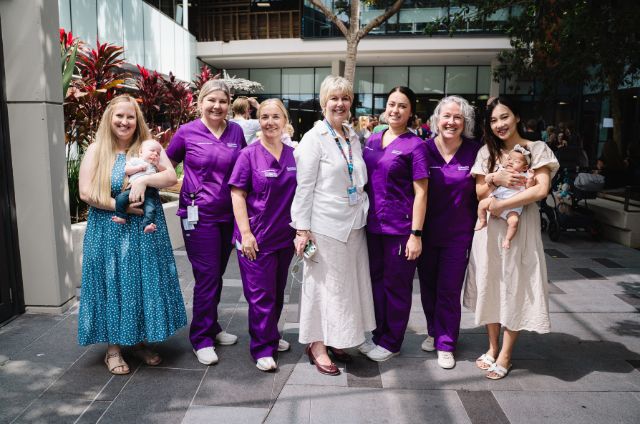Extreme Heat in Cities: Co-Developing Just Adaptation for Urban Tourism
Quick facts
This project tackles the critical need for heat adaptation in cities. As intensifying heatwaves increasingly threaten lives and economic productivity, this study develops a novel measure to assess future tourism-related heat hazards, examines the added strain on city response systems by tourism, and establishes new insights into differentiated vulnerabilities amongst tourists and workers. By integrating a global analysis with three city case studies, this research co-develops innovative responses to reduce heat risk within urban systems. A new set of adaptation principles will help prioritize low-carbon, just responses, implemented through collaborative governance systems across different scales and sectors.
Grants Awarded

Gold Coast Health launches Australian-first digital maternity tool
An innovative digital maternity tool is providing more personalised support for expecting and new mothers on the Gold Coast.
SPASMS: Study of Paediatric Appendicitis Scores and Management Strategies
Quick facts
Dr Natalie Phillips
Prof Meredith Borland AM
A/Prof Shane George
Dr Michelle Davison
Dr Bhavesh Patel
Dr Melissa Short
Dr Wei Hao Lee
Dr Deborah Shellshear
Associate Investigators
Mr Mark Moore
Dr Sarah Davidson
Ms Karla Mulready
Abdominal pain is one of the commonest reasons for children to attend the emergency department (ED), and acute appendicitis is the most common cause of abdominal pain requiring surgery. There are various clinical prediction scores that have been developed to help doctors diagnose appendicitis; however, most scores were developed overseas and are not routinely used in Australian EDs. The aim of this project is to review different published scores and compare them with overall clinician impression in diagnosing acute appendicitis in children presenting to ED.
The project will include all patients presenting to the ED with abdominal pain that are having investigations for possible appendicitis. The treating doctor will be asked to complete a case report form detailing patient history, examination findings, investigation results, as well as their overall clinical impression of the patient’s likelihood of having the diagnosis of appendicitis. Data collected will be analysed by project researchers to determine which scores are the most helpful for clinicians in diagnosing acute appendicitis in children presenting to Australian EDs, with the expectation that this will improve future care provided to children with abdominal pain.
Grants Awarded
Suspected Pulmonary Embolism Exclusion with D-dimers in Emergency Departments (SPEED-ED)
Quick facts
A/Prof Colin Banks
Dr Vinay Gangathimmaiah
A/Prof Jeremy Furyk
Prof Gerben Keijzers
Dr Philip Jones
A/Prof Kevin Chu
Dr Sean Lawrence
Dr Georgia Livesay
Dr Theophilus Emeto
Associate Investigators
Prof Joshua Byrnes
Dr John Casey
Dr Rob Eley
Dr Nathan Brown
Dr Cara Frain
Pulmonary embolism (PE) refers to blood clots in the lung. They can cause sudden death, collapse, chest pain, shortness of breath yet sometimes they cause no symptoms at all and are discovered incidentally. As they can be severe, they have become regarded as a not-to-miss diagnosis. As they can present with a variety of symptoms, emergency clinicians consider the possibility of PE on a frequent basis.
When considering whether a patient has a PE, the clinician may confirm or exclude the diagnosis directly with definitive chest scans. However, these scans are time consuming, costly and have other side effects including exposure to radiation and to chemical contrast agents. When patients are assessed to be less likely of having a PE, it is often possible to safely exclude PE by applying a set of clinical decision rules or doing a blood test called a D-dimer. If the level of D-dimer is below a certain threshold, then PE can be excluded.
We aim to safely exclude PE without scans where possible. Evidence has been building that employing a higher D-dimer threshold is reasonable, yet uptake of this newer approach is limited. We hope to demonstrate that a higher threshold can work in Australia without compromising safety. This will be a large study that answers this question and if shown to be the case, then patient care can be improved while using less resources in busy emergency departments.
Grants Awarded
Minimal interventions for management of kids' distal forearm fractures
Quick facts
Dr Peter Snelling
‘iIMPROVE PSP’ implementation science study to improve outcomes in primary spontaneous pneumothorax (PSP)
Quick facts
Prof Diana Egerton-Warburton
Professor Helena Teede, Associate Professor Joanne Enticott, Professor Julian Smith, Professor Peter Cameron, Professor Cathy Mihalopoulos, Professor Simon Craig, Professor Y C Gary Lee, Professor Simon Brown, Dr Sanjeevan Muruganandan, Professor Gerben Keijzers, Associate Professor Carolyn Hullick, Professor Timothy Baker, Associate Professor Benjamin Kwan, Dr Arash Badiei.
Associate Investigators
Associate Professor Lisa Kuhn, Professor Anne-Maree Kelly, Associate Professor Gerard O'Reilly, Dr Paul Buntine, Dr Long Le, Associate Professor Darren Mansfield, Dr Harshan Jeyakumar, Dr Trevor Chan, Associate Professor Peter Jones, Mr Ethan Bacon, Dr Jeremy Furyk, Dr Emma Ball, Professor Daniel Fatovich, Ms Frances Kinnear, Dr Robert Lee.
The project will involve four essential work packages:
- Stakeholder engagement, evidence synthesis and iIMPROVE PSP pathway development. The team will co-design, evidence-based, tailored, consumer-focused PSP care pathways based on their previous research, evidence synthesis and guidelines, developed by and with consumers using established behaviour change and Learning Health System (LHS) frameworks to answer how to implement high-value care in complex systems.
- A stepped wedge cluster randomised trial to determine the implementation effectiveness of iIMPROVE PSP pathway at scale. Evaluation will use the reach, effectiveness, adoption, implementation and maintenance (RE-AIM) framework.
- Economic Evaluation of iIMPROVE PSP pathway. A within-trial cost-effectiveness analysis will provide a compelling case for scale-up and economic modelling for longer-term benefits.
- The roadmap for national scale-up will include a survey, implementation toolkits and National Clinical Care Standard co-designed with stakeholders including the Australian Commission for Safety and Quality in Healthcare. This will build legacy implementation research capacity in emergency and respiratory care and drive future collaborative research.
“This is an elegantly simple problem; we should be treating the vast majority of patients with primary spontaneous pneumothorax (PSP) with a watchful waiting approach and therefore avoid unnecessary, painful and costly interventions,” Professor Egerton-Warburton said. “High-level evidence clearly demonstrates that this approach is safe and will reduce iatrogenic harm, hospital admissions, recurrence, surgery and days off work. It will deliver high-value care that is better for consumers and the health system.”
Having two spontaneous pneumothoraxes, the project’s consumer lead investigator Ethan has personally experienced the pain of the typical treatment for PSP. His experience will offer the research team insight into the unnecessary harm that patients can experience when old, outdated guidelines are followed when providing care.
Ethan said that the chest-tube treatment he received caused more pain and discomfort than the collapsed lung itself. “I feel like the pain and scarring I experienced was due to a lack of evidence-informed practice,” he said. “I’m grateful that I have the opportunity to contribute to this research project, and that my experience can be used to improve care across Australia. I’m hopeful that through this research, people will receive more effective care for PSP, without unnecessary pain.”
Grants Awarded
Evidence-based Antimicrobial Stewardship: Sustainable Implementation in Primary Care – The EASSI-PC Trial
Quick facts
Prof. Paul Glasziou
Dr Mina Bakhit, Dr Ruby Biezen, Prof. Kirsty Buising , Prof. Joshua Davis, Prof. Tammy Hoffmann, A/Prof. Mark Jones, Prof. Parker Magin, A/Prof. Jo-Anne Manski-Nankervis, Prof. Mark Morgan, Dr Sanne Peters, Prof. Nigel Stocks, Dr Janney Wale, Prof. Gerben Keijzers
Grants Awarded
Confronting the escalating challenge of hospital admissions linked to paediatric respiratory disease in remote Queensland settings.
Quick facts
Grants Awarded
Drug Overdose with Reduced Consciousness: Patient and Staff Perspectives. A Mixed Methods Study
Quick facts
Prof Gerben Keijzers
Prof Robert Ware
Dr Caitlin Brandenburg
Drug overdoses are a common reasons for Emergency Department (ED) presentation. Overdoses may be intentional (self-harm), recreational, or accidental and often lead to reduced consciousness. Patients often need extra attention to their airway and breathing. They can be managed conservatively with oxygen, observation and regular nursing assessments. However, some require intubation: insertion of a breathing tube under sedation.
There is practice variation between doctors as to which overdose patients require intubation. Thus, the patient’s perspective becomes paramount, as their experiences influence management. We also need to understand clinician thought processes to ensure that care is standardised where possible.
This qualitative research is innovative in being the first to assess the patient experience around airway and breathing management for drug overdose with reduced consciousness, and assessing clinician attitudes. This will be done through patient and clinician questionnaires and semi-structured interviews.
AIM 1: To investigate the patient experience for an ED presentation with drug overdose and reduced conscious level. To understand the impact that interventions such as intubation can have on patients.
AIM 2: Explore clinician attitudes to the management of airway and breathing for these patients. Barriers to a conservative approach, triggers for intubation, departmental pressures and existing frameworks of care.
The research will provide insight into how this vulnerable patient population experience their care, and how clinicians reach critical decisions. It will inform development of a pathway of care to be used in the ED assessment of airway and breathing management for patients with drug overdose and reduced consciousness.
Grants Awarded
Research Capacity Building Grant - Gold Coast Health
Quick facts
Prof Gerben Keijzers
Dr Michael Aitken
Dr David Rosengren
Prof Liz Lees-Deutsch
Ms Amy Sweeny
Mr Sandip Kumar
Ms Noela Baglot
Mr Matthew Lunn
Most clinical staff working in the ED are clinical facing, allowing little to no time to develop research or their skills in research. The primary aim of the CBG is to support, develop, and undertake research of importance for Robina ED with Robina ED staff, HHS Executives, and consumers.
Our strategic vision for the CBG is to have research an integral part of clinical practice and education at Robina ED and that guidelines and policies are informed by our research. It will be guided by the GCH ED Research Strategy which has 4 goals: 1) Organise emergency care research; 2) Build and streamline research capacity; 3) Promote excellence, relevance, and impact of research; and 4) Develop, strengthen, and sustain research partnerships.
Structure: To build research capacity specifically for Robina ED staff, the structure will involve the employment of a Robina-based ED Research Fellow (part-time) and Research Nurse (part-time), as well as consultancy from a consumer advisor, and health economist/statistician (see budget); Engagement of health service executives, local and international university academics, collaborators from other agencies; and specific mentorship from other ED research leaders using tested frameworks (NASEM, 2019).
Expected benefits of the CBG include: active research engagement and collaboration leading to partnerships between Robina ED clinicians, researchers, HHS Executive, consumers and external collaborators in the development of 2 projects led by staff at Robina with support from researchers; the development and sustainment of capacity building mechanisms for: research involvement opportunities for Robina ED clinicians, dissemination of research updates and findings, and research mentorship.



